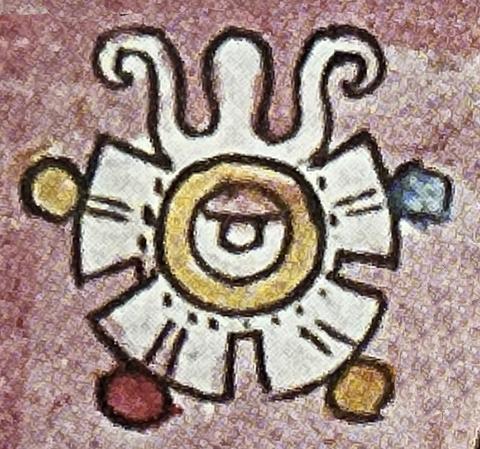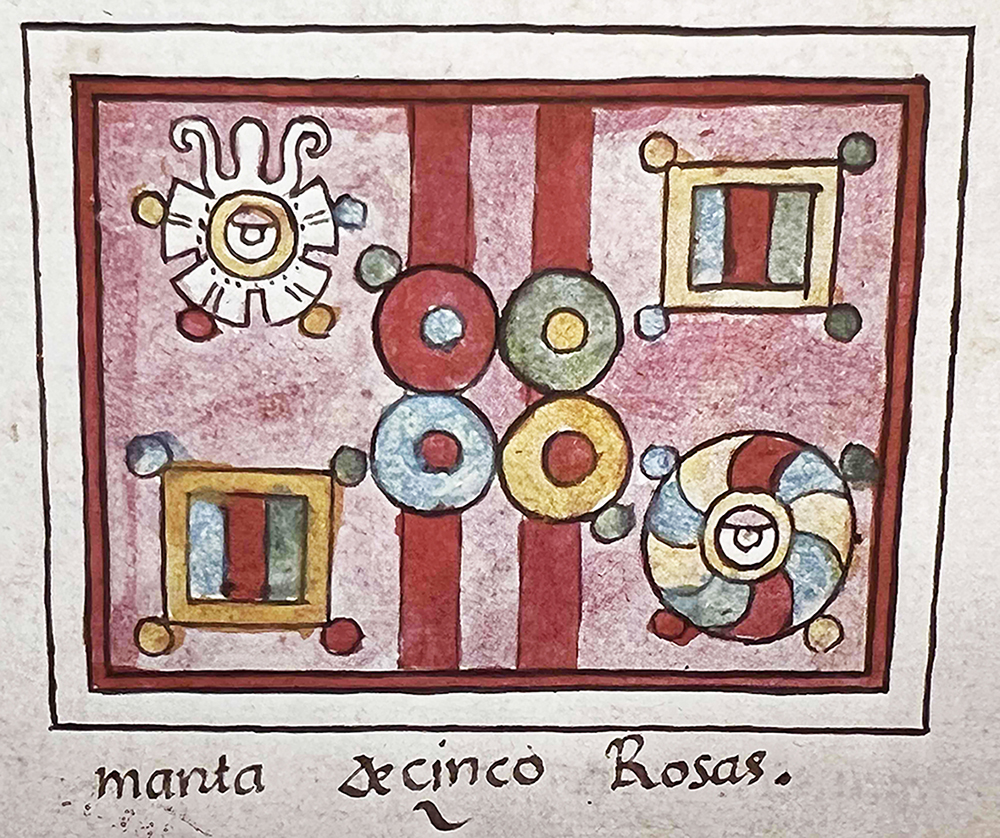papalotl (Mglb4v)
This element from a compound glyph shows a butterfly (papalotl). It has been carved from a cloak featuring five flowers. This butterfly is one of the “flowers,” and it might be considered a tonalli (day, sun, or personal animating force), given that the five flowers are associated with tonaleque. The butterfly is largely circular, but at the top it has what appears to be a head and two antennae, curling at their tips. In the center is the glyph for an eye, with a red eyelid, a white pupil, and a white iris. Surrounding the eye is a yellow band. Around that are black dots. Surrounding the yellow circle are four rectangular shapes with hash marks, possibly wing parts. These four wings, which nearly form an X shape––and therefore a quincunx––are circles that have been painted. Two are yellow, one is red, and one is blue.
Stephanie Wood
This butterfly element appears on a page in the Magliabechi Codex where a cloak with a “Five Flower” design (Macuilxochitl) is featured. This glyph is one of the “flowers,” and yet it resembles a butterfly, which is how we are presenting it here. Compare this butterfly to the warrior costume related to butterflies and called the papalotl design found in the Codex Mendoza (below). Macuilxochitl is a day sign in the calendar that has an association with the deity Xochipilli and the tonaleque, which explains why this “flower” is also therefore a “tonalli.” In the contextualizing image, note how some of the other “flowers” coincide with glyphs for tonalli and ilhuitl, both meaning day (or days).
Stephanie Wood
between 1529 and 1553
Jeff Haskett-Wood
butterflies, mariposas, eyes, ojos

papalo(tl), butterfly, https://nahuatl.wired-humanities.org/content/papalotl
tonal(li), day, sun, or personal animating force, https://nahuatl.wired-humanities.org/content/tonalli
ilhui(tl), day or days, https://nahuatl.wired-humanities.org/content/ilhuitl
Macuilxochitl, Five Flower, https://nahuatl.wired-humanities.org/content/Macuilxochitl
la mariposa
Stephanie Wood
Images of the Magliabechi Codex are hosted by FAMSI at http://www.famsi.org/research/graz/magliabechiano/index.html. They were taken from the Codex Magliabechiano CL. XIII.e (B.R. 232) published in 1970 by Akademische Druk - u. Verlagsanstalt - Graz. This is the best facsimile available.
We are borrowing less than 10% of the images from this manuscript. The details from the Magliabechi Codex that are shared here fall under a Creative Commons Attribution-Non-Commercial-ShareAlike 4.0 International (CC BY-NC-SA 4.0) license. Please only reproduce these images for non-profit and educational purposes, and if you do reproduce an image, please site the FAMSI website, http://www.famsi.org/research/graz/magliabechiano/index.html, and the Visual Lexicon of Aztec Hieroglyphs, https://aztecglyphs.wired-humanities.org/.



